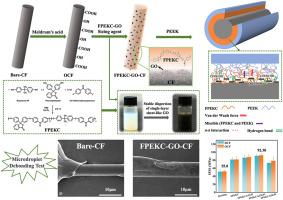含氧化石墨烯的新型耐高温聚芳醚酮施胶剂:在CF/PEEK复合材料中实现多尺度界面增强
IF 9.8
1区 材料科学
Q1 MATERIALS SCIENCE, COMPOSITES
引用次数: 0
摘要
优化碳纤维增强聚醚醚酮(CF/PEEK)复合材料的界面附着力对其力学性能至关重要,但传统的增强策略往往在热稳定性、相容性和环境影响方面存在局限性。为了克服这些挑战,通过分子工程设计并合成了一种新型的以三氟甲基(-CF3)和邻苯酞基团为功能化基团的聚芳醚酮基浆料(FPEKC)。合成的FPEKC表现出出色的热稳定性(t - 5% = 500.45°C),在典型的复合材料加工条件(~ 380°C)下确保了优异的结构完整性。环境可持续的水基FPEKC-GO施胶剂通过乳液-溶剂蒸发技术制备,形成均匀分散的纳米颗粒,平均直径约为60 nm。FPEKC与PEEK基质之间固有的结构相容性促进了广泛的分子扩散和界面上的链间纠缠。此外,将氧化石墨烯(GO)纳米片引入到FPEKC浆料中,在纤维-基质界面建立了强大的化学相互作用,包括氢键和π-π堆叠,以及纳米级机械联锁,实现了多尺度界面增强。CF/PEEK复合材料的界面抗剪强度(IFSS)显著提高65.56%,达到92.38 MPa。此外,复合施胶剂同时使碳纤维单丝的拉伸强度提高了5.56%,有效地减轻了界面缺陷和应力集中。这项研究展示了一种创新的多尺度界面工程策略,为开发环保、高性能的CF/PEEK复合材料提供了新的见解和实用方法。本文章由计算机程序翻译,如有差异,请以英文原文为准。

A novel high-temperature resistant Poly(arylene ether ketone) sizing agent containing graphene oxide: Achieve multiscale interfacial enhancement in CF/PEEK composites
Optimizing the interfacial adhesion in carbon fiber reinforced polyether ether ketone (CF/PEEK) composites is crucial for their mechanical performance, yet conventional enhancement strategies often face limitations in thermal stability, compatibility, and environmental impact. To overcome these challenges, a novel aqueous poly(aryl ether ketone)-based sizing agent (FPEKC), functionalized with trifluoromethyl (-CF3) and phthalide moieties, was designed and synthesized through molecular engineering. The synthesized FPEKC exhibited outstanding thermal stability (T-5 % = 500.45 °C), ensuring excellent structural integrity throughout typical composite processing conditions (∼380 °C). The environmentally sustainable, water-based FPEKC-GO sizing agent prepared via an emulsion-solvent evaporation technique formed uniformly dispersed nanoparticles with an average diameter of approximately 60 nm. The intrinsic structural compatibility between FPEKC and the PEEK matrix facilitated extensive molecular diffusion and interchain entanglement at the interface. Additionally, the introduction of graphene oxide (GO) nanosheets into the FPEKC slurry established robust chemical interactions at the fiber-matrix interface, including hydrogen bonds and π-π stacking, as well as nanoscale mechanical interlocking, achieving multi-scale interface enhancement. The interfacial shear strength (IFSS) of the CF/PEEK composite material was remarkably enhanced by 65.56 %, reaching a value of 92.38 MPa. Furthermore, the composite sizing agent simultaneously improved the tensile strength of individual carbon fiber filaments by 5.56 %, effectively mitigating interfacial defects and stress concentrations. This research demonstrates an innovative multiscale interface engineering strategy, providing new insights and practical methodologies for developing environmentally friendly, high-performance CF/PEEK composites.
求助全文
通过发布文献求助,成功后即可免费获取论文全文。
去求助
来源期刊

Composites Science and Technology
工程技术-材料科学:复合
CiteScore
16.20
自引率
9.90%
发文量
611
审稿时长
33 days
期刊介绍:
Composites Science and Technology publishes refereed original articles on the fundamental and applied science of engineering composites. The focus of this journal is on polymeric matrix composites with reinforcements/fillers ranging from nano- to macro-scale. CSTE encourages manuscripts reporting unique, innovative contributions to the physics, chemistry, materials science and applied mechanics aspects of advanced composites.
Besides traditional fiber reinforced composites, novel composites with significant potential for engineering applications are encouraged.
 求助内容:
求助内容: 应助结果提醒方式:
应助结果提醒方式:


